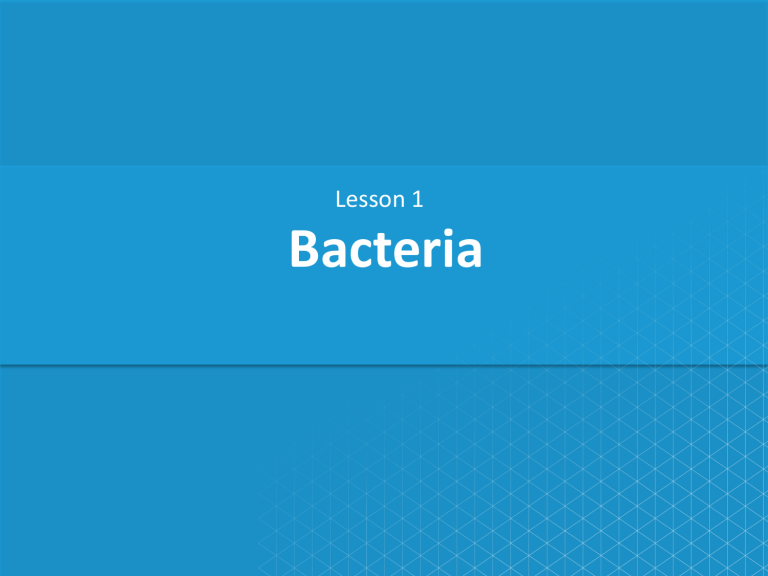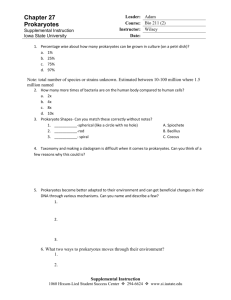
Lesson 1 Bacteria Focus Question What are the differences between the domains of prokaryotes? New Vocabulary bacteria nucleoid capsule pilus binary fission conjugation endospore Review Vocabulary prokaryotic cell: cell that does not contain any membrane-bound organelles Diversity of Prokaryotes • Prokaryotes are divided into two domains: • Bacteria • Archaea • Bacteria (eubacteria) belong to Domain Bacteria, exist in nearly every environment on Earth, and are important to the human body, industry, and food production. • Archaea tolerate extreme environments. They have similar proteins to eukaryotic cells. Diversity of Prokaryotes Archaea • Predominate in extreme environments • Are mostly anaerobic; cannot tolerate oxygen • Include: • halophiles (salt-loving) • methanogens (use CO2 and give off methane) • thermoacidophiles (high temperature, low pH) Diversity of Prokaryotes Differences Between Bacteria and Archaea • Different cell wall proteins • Different lipids in plasma membrane • Different ribosomal proteins and RNA • Archaea ribosomal proteins resemble eukaryotic ribosomal proteins. Prokaryote Structure • Prokaryotes are microscopic, unicellular organisms. • They have some characteristics of all cells, such as DNA and ribosomes. • Prokaryotes lack a nuclear membrane and other membrane-bound organelles. • They have a long, circular chromosome found in the nucleoid. • They usually have at least one smaller piece of DNA called a plasmid, which is also circular. Prokaryote Structure Prokaryote Structure • Some prokaryotes secrete a layer of polysaccharides around the cell well, forming the capsule, which • prevents cell dehydration • helps with attachment to surfaces • protects from antibiotics • Pili (singular: pilus) are submicroscopic hair-like structures made of protein. • Pili help cells attach to surfaces and serve as bridges between cells to send plasmids to each other. Prokaryote Structure • Prokaryotes are only 1-10 micrometers long and 0.7-1.5 micrometers wide. • Their small size makes nutrient diffusion easy. Prokaryote Characteristics Prokaryote Shape • Cocci (spherical or round) • Bacilli (rod-shaped) • Spirilli (spiral-shaped) Prokaryote Characteristics • Scientists classify bacteria based on the composition of their cell walls. • All bacterial cells have peptidoglycan in their cell walls. • Gram staining is a common procedure for identifying main kinds of bacteria. • Bacteria with large amounts of peptidoglycan appear purple when stained; Gram-positive. • Bacteria with lipid layers have less peptidoglycan and appear pink when stained; Gram-negative. • Important for antibiotic treatment Prokaryote Characteristics • Some prokaryotes are stationary, but others use flagella for movement. • Prokaryotic flagella are made of filaments, unlike flagella of eukaryotes, which are made of microtubules. • Other prokaryotes glide over a layer of secreted slime. Reproduction of Prokaryotes • Binary fission is the asexual division of one cell into two identical cells. • In conjugation, two prokaryotes attach to each other and exchange genetic information Prokaryote Reproduction Binary Fission Metabolism of Prokaryotes • Obligate anaerobes cannot live or grow in the presence of oxygen, and obtain energy only through fermentation. • Facultative anaerobes can grow with or without oxygen. • Obligate aerobes require oxygen. • Prokaryotes are also classified by how they obtain energy for cellular respiration or fermentation. Prokaryote Metabolism Prokaryote Metabolism Heterotrophs • Heterotrophs cannot synthesize their own food. They must take in nutrients. • Many heterotrophic prokaryotes are saprotrophs. • They decompose organic material associated with dead organisms or waste. Prokaryote Metabolism Photoautotrophs • Photosynthetic autotrophs, or photoautotrophs, gain energy through photosynthesis. • Photosynthetic bacteria are often cyanobacteria, an important food chain component. Chemoautotrophs • They don’t use light break down inorganic compounds that contain nitrogen or sulfur. • They are important in cycling inorganic compounds, such as nitrogen, through ecosystems. Survival of Bacteria Endospores are dormant cells produced in response to harsh environmental conditions. • Bad conditions: The spore coat surrounds a copy of the chromosome and a small part of the cytoplasm. • Favorable conditions: The spore germinates and grows into a new bacterial cell. Survival of Bacteria Mutations • Genetic mutations can help bacteria survive in changing environments. • Mutations allow for genetic diversity in an asexually reproducing population. • Mutations lead to changes like antibiotic resistance. Ecology of Bacteria • Bacteria are decomposers, returning vital nutrients to the environment. • Some soil bacteria fix nitrogen, which is vital for amino acid, DNA, and RNA synthesis. • Some nitrogen-fixing bacteria live in symbiotic relationships with plants/crops. • Your body is covered in bacteria inside and out. • Normal flora have a symbiotic relationship with humans; they prevent disease, aid with digestion, and make vitamins. Ecology of Bacteria • Bacteria are responsible for some food production. Examples include: • cheese • yogurt • Commercial production of vitamins • Can be used to fight disease/produce antibiotics Ecology of Bacteria Disease-Causing Bacteria • A small percentage of bacteria cause disease. • Bacteria cause disease in two ways: • They multiply quickly at the site of infection before the immune system responds. • They secrete a toxin or harmful substance. Quiz 1. Which organism is not included in Domain Archaea? A cyanobacteria B methanogens C halophiles D thermoacidophiles CORRECT Quiz 2. Which line on the graph best indicates the growth rate of a population of bacteria living in ideal conditions? A line I C line III D line IV CORRECT B line II Quiz 3. Why is an electron microscope useful when studying bacteria? A Electrons can penetrate through the capsules surrounding bacteria. C Bacteria move quickly; the electrons stun the bacteria. B Bacteria are tiny. D Bacteria organelles are small and tightly packed together. CORRECT Quiz 4. Which line on the graph best indicates the growth rate of a population of bacteria exposed to an effective antibiotic? A line I C line III CORRECT B line II D line IV



